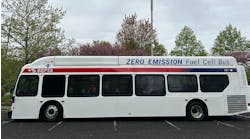CLEVELAND, Ohio — Cleveland’s City Planning Commission took two big steps Friday to update zoning and building code requirements to encourage dense, walkable, transit-oriented neighborhoods.
In the first of two unanimous votes, after nearly three hours of discussion, the commission recommended that City Council approve the implementation of a new form-based zoning code in three pilot neighborhoods — Hough, Opportunity Corridor and Detroit Shoreway / Cudell.
The city views the pilot rezoning as a prelude to wider application across Cleveland, with opportunities to tweak and make adjustments as development unfolds under the new code.
The new zoning is designed to regulate the density and built form of buildings by controlling factors such as height, closer setbacks from streets, and specified amounts of windows to increase ground-level transparency.
The new code would emphasize graphic illustrations of requirements alongside 200 pages of text. It would largely replace, or in some cases work alongside, the existing code, developed in 1929, which largely regulates land use and is expressed primarily through text.
The second vote Friday established new performance standards for a “Transportation Demand Management’' requirements developers would need to meet for projects located in roughly a dozen transit corridors across the city.
Developers seeking construction permits within the corridors would see their applications graded on a point scale designed to reward subsidies for investments such as transit passes for residents and workers, improvements to transit stops, and construction of bicycle storage and parking facilities.
The new standards would also eliminate minimum parking requirements for vehicles within the corridors, which have been mapped as quarter mile-wide strips of land on either side of major transit routes.
City Council voted last year to give the planning commission authority to set the new standards. The new standards will take effect in 30 days, planners said.
Together, the new zoning and the transportation demand standards are intended to shift the city’s design DNA toward achieving Mayor Justin Bibb’s goal of making Cleveland a “15-minute city,’’ in which most needs for daily living can be met within a short walk from home.
In an unusual appearance before the planning commission, Bibb kicked off Friday’s meeting by underscoring his support for the new policies.
“I’m excited about these two initiatives and bringing my vision of prioritizing a vision of people over cars,’’ he said. “We’re a transit city, we’re a bike city, and it’s time we started acting like it.’’
Cleveland first considered exploring form-based zoning in 2015 under then-mayor Frank Jackson. Progress on a developing the pilot project for the three neighborhoods started about six years ago but was slowed by the COVID-19 pandemic.
Cleveland is a relatively late adopter. Form-based zoning has been enacted by more than 360 communities across the U.S.
“Everybody’s exploring zoning reform,’’ Joyce Pan Huang, the city’s planner director, said after Friday’s meeting. “We’re really proud to be a part of that momentum.’’
Fixing what’s broken
City planners who presented the new code at Friday’s meeting said that traditional zoning has made it in many cases illegal to build the mixed-use, transit- and pedestrian-friendly neighborhoods and more affordable housing now in high demand by the real estate market.
Much of what gets built in the city requires variances in a costly, time-consuming process that has slowed housing construction and sometimes killed projects through delays that increased construction and borrowing costs, they said.
Form-based zoning would increase predictable outcomes for residents and developers and reduce costs by cutting red tape and simplifying administration. It would also address issues caused by current zoning, such as abrupt transitions of building height and density between commercial and residential zones. The new code is designed to produce smoother transitions and what planners called a “gentle density.’'
By separating land uses, Cleveland’s traditional zoning has led to a suburbanized, spread out, automobile-oriented pattern. The code has led to shopping strips set far back from sidewalks behind parking lots, and buildings with few ground-level windows or entrances facing streets.
The negative effects of such zoning, which discourages transit use and walking, overlap with disinvestment caused by redlining in city neighborhoods since the 1930s, particularly on the city’s East Side, where lower-income, majority Black communities are most adversely affected.
Work with Cuyahoga County
A presentation describing the new transportation demand management standards showed that none of the census tracts within the city corridors have a housing density of 20 dwelling units per acre, a widely accepted yardstick of what it takes to support transit use.
The one neighborhood that came closest was the Moreland Boulevard area around Shaker Square, which has a density of 16-20 dwelling units per acre.
The corridors affected by the transit demand standards in the city overlap with those defined by the Cuyahoga County Planning Commission in a study that recommends rezoning some 85 square miles of land along 22 commercial corridors in Cleveland and 25 suburbs to encourage dense, walkable, transit-oriented development.
The Greater Cleveland Regional Transit Authority has supported the county project, and the suburb of Garfield Heights aspires to be an early adopter of the new “TOD’' zoning.
The city and county policies and proposals are designed to encourage development and population growth in Greater Cleveland’s urban core, including the city and inner ring suburbs.
Decades of highway-enabled sprawl coincided with Cleveland’s loss of nearly two-thirds of its peak population of nearly 915,000 in 1950. Sprawl development also divided the region into tax base winners and losers.
Between 1960 and 2018, Cleveland lost 66% of its commercial, industrial and residential tax base, according to research conducted for cleveland.com and The Plain Dealer by scholars at Cleveland State University. The data were first reported in 2020.
Building the 15-minute city
The term 15-minute city, which is guiding much of Cleveland’s current planning efforts, was coined in 2016 by Carlos Moreno, a professor at the Sorbonne in Paris. The catch phrase crystallizes the notion that cities should be made up of neighborhoods that make basic necessities such as work, school and shopping readily available.
Conservative critics and conspiracy theorists have derided the concept as a plot to limit personal freedoms. Advocates, including planners who spoke at Friday’s meeting, said planning for walkable density could make it possible to avoid spending the estimated cost of more than $12,000 a year to own a new car.
“Someone could bank that money because they could walk or ride RTA or bike to where they need to do,’’ said Andrew Sargeant, a member of the planning commission and director of open space and planning at the nonprofit Cleveland Neighborhood Progress. “That makes their life more affordable.”
During a public hearing on the proposed new zoning code, more than a dozen residents said they had mixed views on the regulations.
Several complained they received postcards about Friday’s meeting just a few days before the gathering. They also expressed fears that form-based zoning would lead to gentrification and displacement of low- and middle-income residents through new development that would raise rents and property taxes.
Responding to the criticism about the postcards, Huang said, “it’s a process we’re going to look into. We’re very much aware of the critical need to pursue multiple forms of notice and we’ll work on it.’’
Shannan Leonard, the chief city planner specializing in zoning, sought to allay fears about gentrification by saying that enabling a wider range of housing types through form-based zoning would help stabilize communities.
During the public hearing, architect Alex Pesta, a principal of the Cleveland firm of City Architecture, said he firmly supported the form-based code.
“The current zoning code does not work. It is a broken, almost 100-year-old document. Almost every single project we work on requires a handful of variances. We are trying to build up parts of city that have seen disinvestment. A lot of the codes in place make that approach illegal. It is an exhaustive process.’’
After the meeting closed, Huang said she was pleased that the new zoning and transit demand standards won approval.
“These changes are going to help our city be a city,’’ she said. “There is a market and a desire and an interest in living in cities. We want to make Cleveland that place for our residents.”
©2024 Advance Local Media LLC. Visit cleveland.com. Distributed by Tribune Content Agency, LLC.


